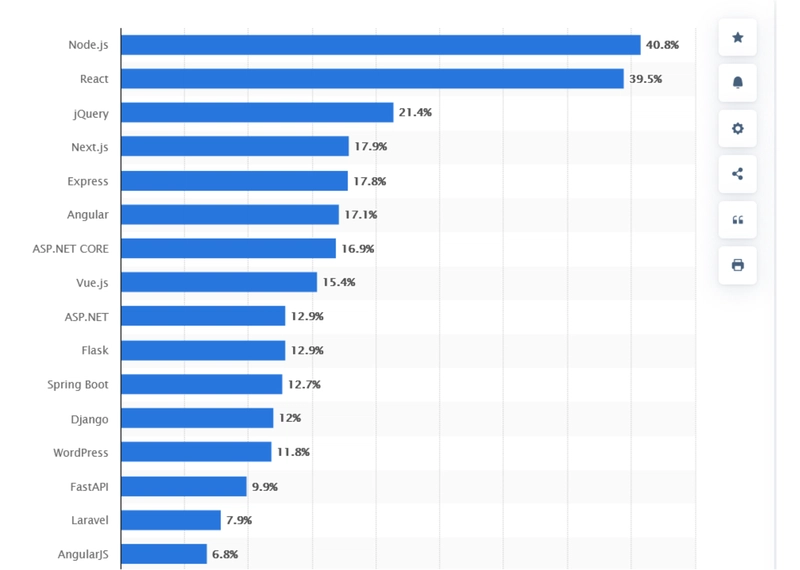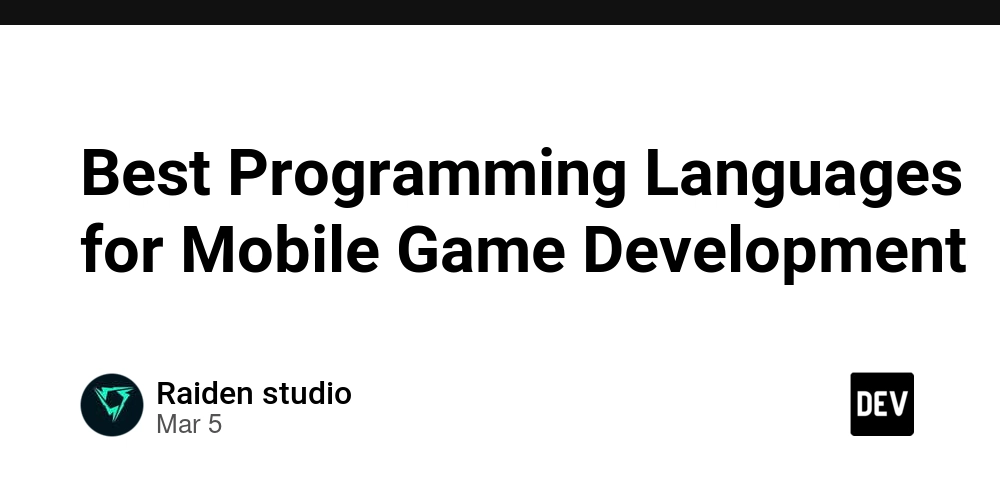A Beginner’s Guide to Choosing the Best Web Development Frameworks
Rahul had a brilliant idea for a website that could revolutionize how people interact with online learning. With excitement, he grabbed his laptop and started writing code. But within hours, his patience left. He realized he was spending too much time figuring out how to structure the project, handle database connections, and ensure security. That’s when he switched to web development frameworks and got a game-changing, efficient, and simplified solution. In today’s fast-paced digital world, efficiency is key. Whether you’re an aspiring developer like Rahul or a seasoned professional, building a website or web application from scratch can be overwhelming. Web development frameworks provide a structured foundation, making development faster, more secure, and scalable. But with so many options available, how do you choose the right one for your project? In this guide, we’ll break down what web development frameworks are, explore some of the top web development frameworks, and help you decide which one suits your needs best. What Are Web Development Frameworks? A web development framework is a pre-written collection of code that provides developers with the necessary tools and functionalities to build websites and applications. These frameworks streamline the development process by offering reusable components, enforcing best practices, and simplifying complex tasks such as database integration, authentication, and user interface design. According to a 2023 survey by Stack Overflow, over 80% of professional developers use a web development framework for their projects, demonstrating the widespread adoption of these tools. Web development frameworks can be broadly classified into frontend and backend frameworks. Frontend frameworks focus on building a web application’s user interface and user experience. They include popular options like React, Angular, and Vue.js, which offer various features such as component-based development, two-way data binding, and virtual DOM implementations. Backend frameworks, on the other hand, handle server-side logic, database interactions, and application architecture. Well-known backend frameworks include Django, Ruby on Rails, and Express.js, each providing different levels of abstraction, scalability, and security. Why Use a Web Development Framework? Web development frameworks play a vital role in modern application development. One of their biggest advantages is increased productivity. Developers do not have to write similar repeated code (boilerplate code) from scratch, as frameworks provide pre-built components and tools that simplify tasks such as routing, authentication, and form validation. According to a report by W3Techs, over 60% of the top 1 million websites use a framework to streamline development. Security is another crucial benefit, as many frameworks come with built-in protection against common vulnerabilities such as SQL injection, cross-site scripting (XSS), and cross-site request forgery (CSRF). Additionally, frameworks encourage best practices by enforcing design patterns and code structuring guidelines, which results in cleaner, more maintainable code. Debugging and maintenance are also simplified, as a structured framework makes it easier to troubleshoot issues, modify features, and scale applications as needed. Lastly, scalability is a key factor, as frameworks facilitate the development of applications that can handle increasing traffic and growing user bases efficiently. Top Web Development Frameworks There are many top web development frameworks available, each with its strengths. Understanding their features and use cases can help you select the right one for your project. Frontend Frameworks These frameworks focus on building a website’s user interface (UI) and user experience (UX). They handle how web pages look and behave in a browser. 1. React React, developed by Meta, is a component-based library used to create interactive user interfaces. It allows developers to build reusable UI elements, making it highly efficient for single-page applications (SPAs). With strong community support and a vast ecosystem, React is widely used by companies such as Facebook, Instagram, and Airbnb. According to the 2024 Statista Survey, React is the most commonly used frontend framework, with approximately 40% of developers favoring it. 2. Angular Angular, developed by Google, is a full-fledged framework based on TypeScript. It comes with built-in features like dependency injection, two-way data binding, and modular architecture. Its extensive capabilities make it a great choice for enterprise-grade applications that require scalability and maintainability. Many large organizations, including Microsoft and Forbes, use Angular for their web applications. Angular holds about 17 % of the frontend framework market, making it a popular choice among developers, as per Statista’s 2024 sur

Rahul had a brilliant idea for a website that could revolutionize how people interact with online learning. With excitement, he grabbed his laptop and started writing code. But within hours, his patience left.
He realized he was spending too much time figuring out how to structure the project, handle database connections, and ensure security. That’s when he switched to web development frameworks and got a game-changing, efficient, and simplified solution.
In today’s fast-paced digital world, efficiency is key. Whether you’re an aspiring developer like Rahul or a seasoned professional, building a website or web application from scratch can be overwhelming. Web development frameworks provide a structured foundation, making development faster, more secure, and scalable. But with so many options available, how do you choose the right one for your project?
In this guide, we’ll break down what web development frameworks are, explore some of the top web development frameworks, and help you decide which one suits your needs best.
What Are Web Development Frameworks?
A web development framework is a pre-written collection of code that provides developers with the necessary tools and functionalities to build websites and applications. These frameworks streamline the development process by offering reusable components, enforcing best practices, and simplifying complex tasks such as database integration, authentication, and user interface design.
According to a 2023 survey by Stack Overflow, over 80% of professional developers use a web development framework for their projects, demonstrating the widespread adoption of these tools. Web development frameworks can be broadly classified into frontend and backend frameworks.
Frontend frameworks focus on building a web application’s user interface and user experience. They include popular options like React, Angular, and Vue.js, which offer various features such as component-based development, two-way data binding, and virtual DOM implementations.
Backend frameworks, on the other hand, handle server-side logic, database interactions, and application architecture. Well-known backend frameworks include Django, Ruby on Rails, and Express.js, each providing different levels of abstraction, scalability, and security.
Why Use a Web Development Framework?
Web development frameworks play a vital role in modern application development. One of their biggest advantages is increased productivity.
Developers do not have to write similar repeated code (boilerplate code) from scratch, as frameworks provide pre-built components and tools that simplify tasks such as routing, authentication, and form validation.
According to a report by W3Techs, over 60% of the top 1 million websites use a framework to streamline development.
Security is another crucial benefit, as many frameworks come with built-in protection against common vulnerabilities such as SQL injection, cross-site scripting (XSS), and cross-site request forgery (CSRF).
Additionally, frameworks encourage best practices by enforcing design patterns and code structuring guidelines, which results in cleaner, more maintainable code.
Debugging and maintenance are also simplified, as a structured framework makes it easier to troubleshoot issues, modify features, and scale applications as needed.
Lastly, scalability is a key factor, as frameworks facilitate the development of applications that can handle increasing traffic and growing user bases efficiently.
Top Web Development Frameworks
There are many top web development frameworks available, each with its strengths. Understanding their features and use cases can help you select the right one for your project.
Frontend Frameworks
These frameworks focus on building a website’s user interface (UI) and user experience (UX). They handle how web pages look and behave in a browser.
1. React
React, developed by Meta, is a component-based library used to create interactive user interfaces. It allows developers to build reusable UI elements, making it highly efficient for single-page applications (SPAs).
With strong community support and a vast ecosystem, React is widely used by companies such as Facebook, Instagram, and Airbnb.
According to the 2024 Statista Survey, React is the most commonly used frontend framework, with approximately 40% of developers favoring it.
2. Angular
Angular, developed by Google, is a full-fledged framework based on TypeScript. It comes with built-in features like dependency injection, two-way data binding, and modular architecture. Its extensive capabilities make it a great choice for enterprise-grade applications that require scalability and maintainability.
Many large organizations, including Microsoft and Forbes, use Angular for their web applications. Angular holds about 17 % of the frontend framework market, making it a popular choice among developers, as per Statista’s 2024 survey.
3. Vue.js
Vue.js is a lightweight and easy-to-learn framework that offers flexibility and an incremental adoption strategy. With a gentle learning curve, Vue is popular among both beginners and experienced developers. It is well-suited for building small to large-scale applications, and companies like Alibaba, Xiaomi, and GitLab have adopted Vue.js in their projects.
According to GitHub stars, Vue.js is one of the fastest-growing frameworks, with over 200,000 stars on its repository.
4. Svelte
Svelte is another emerging frontend framework that compiles components into highly efficient JavaScript code.
Unlike React or Vue, Svelte eliminates the need for a virtual DOM, resulting in faster rendering and better performance. It is gaining popularity for building lightweight and high-performance web applications.
Backend Frameworks
On the other hand, back-end frameworks deal with the server, database, and application logic. They process user requests, manage authentication, and send data to the front end.
1. Django
Django, built with Python, follows a “batteries-included” approach, meaning it comes with numerous built-in features such as authentication, an Object-Relational Mapper (ORM), and security mechanisms. It is known for its rapid development capabilities and scalability, making it an excellent choice for large-scale applications.
Instagram, Pinterest, and The Washington Post rely on Django for their backend systems. According to JetBrains’ State of Developer Ecosystem Report, Django is the second most popular Python framework, after Flask.
2. Express.js
Express.js, a minimalistic framework for Node.js, is highly flexible and lightweight. It is widely used for building REST APIs and microservices due to its unopinionated structure, allowing developers to choose their preferred tools and libraries.
Companies like Uber, LinkedIn, and PayPal leverage Express.js to build scalable applications. Express.js powers approximately 20% of Node.js applications, making it a top choice for developers working with JavaScript.
3. Node.js
Node.js, while not a traditional framework, is a runtime environment that allows JavaScript to be used for server-side development. It has revolutionized backend development by enabling non-blocking, event-driven architecture, making it an excellent choice for real-time applications such as chat applications, streaming services, and online gaming platforms.
Companies like Netflix, eBay, and Trello use Node.js to build scalable applications with high performance. According to the 2024 Statista Survey, Node.js remains one of the most popular backend technologies, with over 40.8% of developers using it for web development.
4. Laravel
Laravel, a PHP-based framework, is known for its elegant syntax and extensive feature set, including ORM, authentication, and templating.
Laravel simplifies complex tasks and provides built-in security mechanisms, making it a preferred choice for developers building robust web applications.
5. Spring Boot
Spring Boot, a Java-based framework, is widely used in enterprise applications for its microservices architecture and extensive ecosystem. It provides a streamlined way to create powerful and scalable backend services.
Web Development Frameworks: Trends and Future Outlook
The landscape of web development frameworks is constantly evolving, with new trends shaping the future of web applications. One notable trend is the rise of serverless frameworks, eliminating the need for traditional server management.
Technologies like Next.js and Nuxt.js are gaining popularity for their ability to create scalable applications with better performance. According to a survey by Vercel, Next.js adoption grew by 50% in the past year, indicating its rising influence in the web development ecosystem.
Another key development is the shift towards the Jamstack architecture, which combines JavaScript, APIs, and Markup (JAM) to build fast, secure, and scalable websites. The Jamstack ecosystem has grown by 85% in the past two years, with companies like Netlify and Vercel leading the charge.
Artificial intelligence (AI) and machine learning integration in web applications is also increasing, with frameworks incorporating AI-driven features for enhanced personalization and automation.
Additionally, there is a growing emphasis on improving the developer experience, with frameworks focusing on ease of use, better documentation, and enhanced tooling to streamline the development process.
As web applications become more complex, the demand for frameworks that offer better performance optimization, modular architecture, and real-time capabilities continues to grow.
Choosing the Right Web Development Framework for Your Project
After exploring different frontend and backend frameworks, you need to understand the way to choose the right framework for you. The following are some related guidelines:
- The complexity and size of your project play a crucial role in selection; large-scale applications may require robust frameworks like Angular or Django, whereas smaller projects may benefit from lightweight options like Vue.js or FastAPI.
- Scalability is another important factor; if you anticipate significant user growth, frameworks known for scalability, such as Node.js, Spring Boot, or Express.js, are excellent choices.
- The learning curve should also be considered; some frameworks, like React and Vue.js, are beginner-friendly, while others, such as Angular and Spring Boot, require more expertise.
- Additionally, the strength of the framework’s community and ecosystem can make a difference; frameworks like React and Django have extensive documentation and third-party libraries that ease development.
- Finally, if performance is a priority, frameworks like Svelte and FastAPI offer excellent efficiency with minimal overhead. By evaluating these factors, developers can make an informed choice that ensures their project’s success.
Conclusion
Web development frameworks simplify the process of building websites and applications by providing ready-to-use structures and best practices. Whether you need a top web development framework for frontend or backend development, selecting the right one depends on your project requirements and personal or team expertise.
Understanding what web development frameworks are and how they function will empower you to make an informed decision that ensures efficiency, scalability, and security for your web application.
By considering factors like scalability, ease of use, performance, and community support, developers can choose a framework that aligns with their goals and delivers a high-quality digital product.












































































































































































![[The AI Show Episode 142]: ChatGPT’s New Image Generator, Studio Ghibli Craze and Backlash, Gemini 2.5, OpenAI Academy, 4o Updates, Vibe Marketing & xAI Acquires X](https://www.marketingaiinstitute.com/hubfs/ep%20142%20cover.png)



























































































































![[DEALS] The Premium Learn to Code Certification Bundle (97% off) & Other Deals Up To 98% Off – Offers End Soon!](https://www.javacodegeeks.com/wp-content/uploads/2012/12/jcg-logo.jpg)


![From drop-out to software architect with Jason Lengstorf [Podcast #167]](https://cdn.hashnode.com/res/hashnode/image/upload/v1743796461357/f3d19cd7-e6f5-4d7c-8bfc-eb974bc8da68.png?#)








































































































.png?#)

































_Christophe_Coat_Alamy.jpg?#)
 (1).webp?#)





































































































![Apple Considers Delaying Smart Home Hub Until 2026 [Gurman]](https://www.iclarified.com/images/news/96946/96946/96946-640.jpg)
![iPhone 17 Pro Won't Feature Two-Toned Back [Gurman]](https://www.iclarified.com/images/news/96944/96944/96944-640.jpg)
![Tariffs Threaten Apple's $999 iPhone Price Point in the U.S. [Gurman]](https://www.iclarified.com/images/news/96943/96943/96943-640.jpg)





































































































































